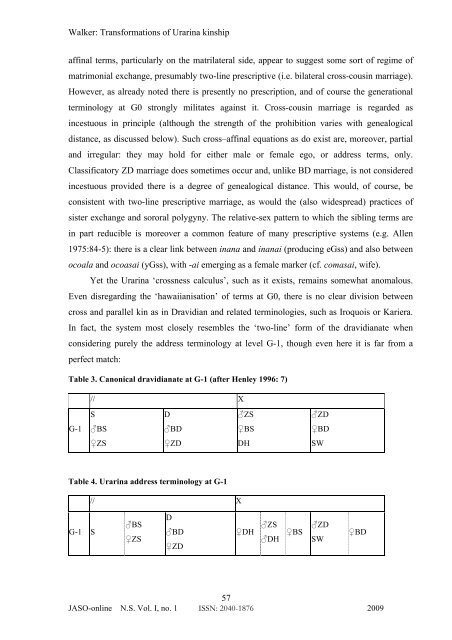Harry Walker: Transformations of Urarina kinship - Institute of Social ...
Harry Walker: Transformations of Urarina kinship - Institute of Social ...
Harry Walker: Transformations of Urarina kinship - Institute of Social ...
You also want an ePaper? Increase the reach of your titles
YUMPU automatically turns print PDFs into web optimized ePapers that Google loves.
<strong>Walker</strong>: <strong>Transformations</strong> <strong>of</strong> <strong>Urarina</strong> <strong>kinship</strong><br />
affinal terms, particularly on the matrilateral side, appear to suggest some sort <strong>of</strong> regime <strong>of</strong><br />
matrimonial exchange, presumably two-line prescriptive (i.e. bilateral cross-cousin marriage).<br />
However, as already noted there is presently no prescription, and <strong>of</strong> course the generational<br />
terminology at G0 strongly militates against it. Cross-cousin marriage is regarded as<br />
incestuous in principle (although the strength <strong>of</strong> the prohibition varies with genealogical<br />
distance, as discussed below). Such cross–affinal equations as do exist are, moreover, partial<br />
and irregular: they may hold for either male or female ego, or address terms, only.<br />
Classificatory ZD marriage does sometimes occur and, unlike BD marriage, is not considered<br />
incestuous provided there is a degree <strong>of</strong> genealogical distance. This would, <strong>of</strong> course, be<br />
consistent with two-line prescriptive marriage, as would the (also widespread) practices <strong>of</strong><br />
sister exchange and sororal polygyny. The relative-sex pattern to which the sibling terms are<br />
in part reducible is moreover a common feature <strong>of</strong> many prescriptive systems (e.g. Allen<br />
1975:84-5): there is a clear link between inana and inanai (producing eGss) and also between<br />
ocoala and ocoasai (yGss), with -ai emerging as a female marker (cf. comasai, wife).<br />
Yet the <strong>Urarina</strong> ‘crossness calculus’, such as it exists, remains somewhat anomalous.<br />
Even disregarding the ‘hawaiianisation’ <strong>of</strong> terms at G0, there is no clear division between<br />
cross and parallel kin as in Dravidian and related terminologies, such as Iroquois or Kariera.<br />
In fact, the system most closely resembles the ‘two-line’ form <strong>of</strong> the dravidianate when<br />
considering purely the address terminology at level G-1, though even here it is far from a<br />
perfect match:<br />
Table 3. Canonical dravidianate at G-1 (after Henley 1996: 7)<br />
// X<br />
S<br />
D<br />
♂ZS<br />
♂ZD<br />
G-1<br />
♂BS<br />
♂BD<br />
♀BS<br />
♀BD<br />
♀ZS<br />
♀ZD<br />
DH<br />
SW<br />
Table 4. <strong>Urarina</strong> address terminology at G-1<br />
// X<br />
G-1 S<br />
♂BS<br />
♀ZS<br />
D<br />
♂BD<br />
♀ZD<br />
♀DH<br />
♂ZS<br />
♂DH<br />
♀BS<br />
♂ZD<br />
SW<br />
♀BD<br />
57<br />
JASO-online N.S. Vol. I, no. 1 ISSN: 2040-1876 2009
















